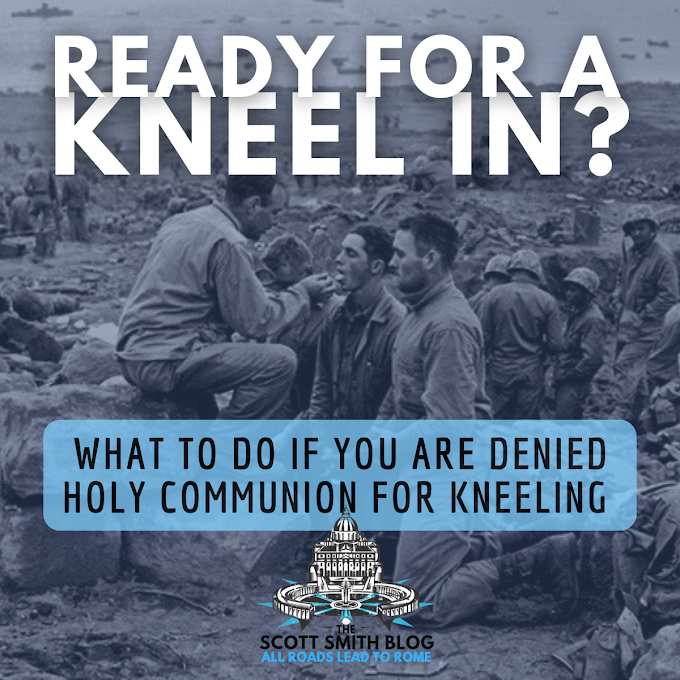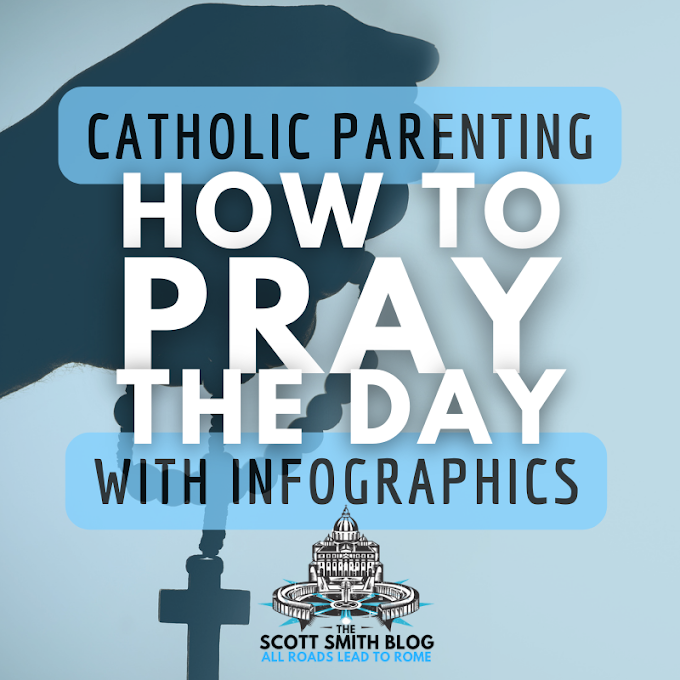Happy Feast of Saint Elizabeth of the Visitation!
Mary's visit to Elizabeth was no ordinary family visit. Why does the baby leap in Elizabeth's womb? What other historical event happened in Saint Elizabeth's neighborhood? And what does King David have to do with all this?
I have created an e-course on all the amazing parallels between the Old Testament and the New Testament about Mary. Mary is the New Eve. Mary is the New Ark of the Covenant (more on that below). Mary is the New Queen of Israel. Every Catholic needs to know about these Mary connections!
Want an entire e-course on Mary to learn about all these connections? Enroll now at All Saints University.
Click HERE to learn more. Plus, here is the introductory video to the Mary course:
Now, here are the answers to all the Marian riddles in Luke's account of the Visitation. Get ready to be amazed:
What is Really Happening at the Visitation?
At the Visitation, Luke is making some amazing connections between Mary and events of the Old Testament. Luke is connecting Mary to the Ark of the Old Testament. Here is the scene that Luke is referencing from the Old Testament, 2 Samuel 6: 2, 5-16, 23, reproduced with emphasis below:
(2) And David arose and went with all the people who were with him from Ba′ale-judah, to bring up from there the ark of God, which is called by the name of the Lord of hosts who sits enthroned on the cherubim ... (5) And David and all the house of Israel were making merry before the Lord with all their might, with songs and lyres and harps and tambourines and castanets and cymbals. (6) And when they came to the threshing floor of Nacon, Uzzah put out his hand to the ark of God and took hold of it, for the oxen stumbled. (7) And the anger of the Lord was kindled against Uzzah; and God smote him there because he put forth his hand to the ark; and he died there beside the ark of God.
(8) And David was angry because the Lord had broken forth upon Uzzah; and that place is called Pe′rez-uz′zah, to this day. (9) And David was afraid of the Lord that day; and he said, “How can the ark of the Lord come to me?” (10) So David was not willing to take the ark of the Lord into the city of David; but David took it aside to the house of O′bed-e′dom the Gittite. (11) And the ark of the Lord remained in the house of O′bed-e′dom the Gittite three months; and the Lord blessed O′bed-e′dom and all his household.
(12) And it was told King David, “The Lord has blessed the household of O′bed-e′dom and all that belongs to him, because of the ark of God.” So David went and brought up the ark of God from the house of O′bed-e′dom to the city of David with rejoicing; (13) and when those who bore the ark of the Lord had gone six paces, he sacrificed an ox and a fatling. (14) And David danced before the Lord with all his might; and David was girded with a linen ephod. (15) So David and all the house of Israel brought up the ark of the Lord with shouting, and with the sound of the horn.
(16) As the ark of the Lord came into the city of David, Michal the daughter of Saul looked out of the window, and saw King David leaping and dancing before the Lord; and she despised him in her heart ... (22) And Michal the daughter of Saul had no child [until] the day of her death.
Gospel of Luke: The Visitation of St. Elizabeth
Now re-read Luke's account of the Visitation at Luke 1:39-45, 56:
In those days Mary arose and went with haste into the hill country, to a city of Judah, and she entered the house of Zechari′ah and greeted Elizabeth. And when Elizabeth heard the greeting of Mary, the babe leaped in her womb; and Elizabeth was filled with the Holy Spirit and she exclaimed with a loud cry, “Blessed are you among women, and blessed is the fruit of your womb! And why is this granted me, that the mother of my Lord should come to me? For behold, when the voice of your greeting came to my ears, the babe in my womb leaped for joy. And blessed is she who believed that there would be a fulfillment of what was spoken to her from the Lord.” [Mary sings her Magnificat] ... And Mary remained with her about three months, and returned to her home.
Did you notice any lines from the "Hail Mary" prayer?
Let's go through all these connections one-by-one:
Elizabeth is quoting King David when she announces Mary's arrival. Luke is plainly equating the "ark of the Lord" and the "mother of my Lord."
Visitation: Mary is the New Ark
"And why is this granted me, that the mother of my Lord should come to me?"
Elizabeth says this to Mary, but what does David say at 2 Samuel 6:9? "How can the ark of the Lord come to me?" Elizabeth just replaces "the mother" for "the ark".Elizabeth is quoting King David when she announces Mary's arrival. Luke is plainly equating the "ark of the Lord" and the "mother of my Lord."
The babe "leaped for joy"
Where could there possibly be a connection here, right? There's no baby at all described in 2 Samuel 6. But there were people "leaping" in both passages: King David was "leaping and dancing before the Lord". Therefore, both King David the and the unborn John the Baptist were leaping before the Ark.Not only that, there were both naked! Michal, the one who is struck barren, rebukes David at 2 Samuel 6:20: “How the king of Israel honored himself today, uncovering himself today before the eyes of his servants’ maids, as one of the vulgar fellows shamelessly uncovers himself!” Michal reveals that David was "uncovered" in public.
"Three months"
Did you notice the amount of time that the Ark of the Lord remained at the house of Obed-edom? It was "three months" (verse 11). And how long did Mary, the New Ark, remain at the house of Elizabeth? Again, three months! Check out verse 56."Arose and went" & "The hill country" of Judah
First off, the first few words of both passages are repeated: David "arose and went" and Mary, too, "arose and went". These are all tags used by Luke to connect the passages. Moreover, David was coming from "Ba′ale-judah" and Mary was headed "in haste" into "the hill country, to a city of Judah."Both were in the lands of Judah.
 |
| The beautiful Hill Country of Judah |
Elizabeth lived in the "hill country" of Judah. But "what has this to do" with King David and the Ark? Where is the Ark headed in 2 Samuel 6? In this chapter, the Ark travels from Abinadab in Gibeah to the house of Obededom the Gittite1 and then to the "City of David." So where were all these locations?
Before the Ark arrived at the house of Obed-edom, Uzzah made his fateful mistake (more on why this was a mistake below). The place where he touched the Ark and was smote dead by God is called "Perez-Uzzah to this day" according to 2 Samuel 6:8. While "to this day" was quite a long time ago, the place is still known.
After Uzzah's mistake, David hesitated in bringing the Ark into the "City of David." The "City of David" is Jerusalem, and David and his group were almost there.
All of these places - Baale-Judah, the "threshing floor of Nacon," Perez-Uzzah, and the house of Obed-edom - are all within a couple miles of each other. These are all near the ancient city of Kirjath-jearim, which is northwest of Jerusalem.2
So if Kirjath-jearim is where the events of 2 Samuel 6 took place, where was the home of Zechariah and Elizabeth?
Zechariah and Elizabeth's home is well known. It is near Ein Karem. Zechariah had two homes, one in the valley and a summer home higher up on the hillside, where it was cooler. The home in the valley is the site of the Church of the Nativity of John the Baptist. The home up on the hillside is the site of the Church of the Visitation.
 |
| Church of the Visitation and Gorny Monastery, Ein Karem, near Jerusalem |
How far apart do you think the site of the Visitation is from the house of Obed-edom, near Kirjath-jearim? Would it surprise you to learn that they are only about 3-4 miles apart as the crow flies?
"Exclaimed"
At Luke 1:42, Elizabeth bursts out with an exuberant cry. Elizabeth "exclaimed with a loud cry, 'Blessed are you among women, and blessed is the fruit of your womb!'" She is basically the first human to pray the "Hail Mary!" Remember that you are repeating the words of Elizabeth and the Angel Gabriel when we pray this ancient prayer.The particular expression used for "exclaim" is very interesting. It is rarely used in the Bible and only ever in a very specific context. This is actually the only time it is found at all in the New Testament.
Every time "exclaimed" is used in the Old Testament, it refers to the music of the Levitical singers and musicians that accompanied processions of the Ark of the Covenant. It described the "exultant" sound of instruments as the Ark processed into Jerusalem with King David (1 Chronicles 15:28) and into the Temple with King Solomon (2 Chronicles 5:13).
In 2 Samuel 6, the processions of the Ark are also accompanied by music, instruments, and shouting: (verse 5) "And David and all the house of Israel were making merry before the Lord with all their might, with songs and lyres and harps and tambourines and castanets and cymbals"; and (verse 15) "So David and all the house of Israel brought up the ark of the Lord with shouting, and with the sound of the horn."
In summary, when Elizabeth "exlaims" before Mary, she is singing as the New Ark is processing into her home, just as the Levites did at the processions of the original Ark. And, there's one more thing. Elizabeth was a Levite!
Like "exclaim," the particular expression for "overshadow" occurs no where else in the New Testament or even Scripture, except at Exodus 40:34-35:
What was the principal object found within the Tabernacle? The Ark of the Covenant.
Luke, therefore, is referencing the way the Spirit of God came upon the Ark as the Glory Cloud (Hb. shekinah) to describe the way the Spirit of God will come to the Virgin Mary, the New Ark. Amazing!
Here are some additional insights on Mary provided by 2 Samuel 6:
In summary, when Elizabeth "exlaims" before Mary, she is singing as the New Ark is processing into her home, just as the Levites did at the processions of the original Ark. And, there's one more thing. Elizabeth was a Levite!
"Overshadow"
Just as the expression for "exclaim" found in the Visitation is reserved for a certain context in Scripture, so, too, is the word "overshadow." The verse containing "overshadow" occurs a little bit earlier in the Gospel of Luke. It is found at the Annunciation. If you will recall, the Angel Gabriel said to Mary at Luke 1:35, "The Holy Spirit will come upon you, and the power of the Most High will overshadow you."Like "exclaim," the particular expression for "overshadow" occurs no where else in the New Testament or even Scripture, except at Exodus 40:34-35:
Then the cloud covered the meeting tent, and the glory of the LORD filled the Tabernacle. Moses could not enter the meeting tent, because the cloud settled down upon it and the glory of the LORD filled the Tabernacle.
What was the principal object found within the Tabernacle? The Ark of the Covenant.
Luke, therefore, is referencing the way the Spirit of God came upon the Ark as the Glory Cloud (Hb. shekinah) to describe the way the Spirit of God will come to the Virgin Mary, the New Ark. Amazing!
Here are some additional insights on Mary provided by 2 Samuel 6:
Perpetual Virginity of Mary
The Incident with Uzzah
So why did God strike Uzzah dead? That seems right out of left field. All Uzzah did was try to stop the Ark from falling off the cart, right?Not quite. God's original command was for the priests, specifically the Levitical priests, to carry the Ark using the golden poles and rings provided at Exodus 25. Uzzah and his brother were not priests, and the oxen pulling the cart were certainly not priests.
On top of this irreverence, Numbers 4:15 specifically forbade the Kohathites, such as Uzzah, from touching the Ark and "the holy things, or they will die." God always remembers his promises.
But what might this scene say about Mary? If merely touching the original Ark could mean death, what would happen if a mortal man touched, let alone conceived with, the Virgin Mary, the spouse of the Holy Spirit? This scene with Uzzah, therefore, provides typological proof for the dogma of the Perpetual Virginity of Mary.
"Until the day of her death"
For the hate she bore in her heart for King David, Michal was struck barren, not unlike Uzzah being struck down dead. Elizabeth, too, was believed to be barren, which again connects 2 Samuel 6 to Luke 1.But there's more! One of the verses most frequently cited to disprove the Perpetual Virginity of Mary is Matthew 1:24-25:
When Joseph woke from sleep, he did as the angel of the Lord commanded him; he took his wife, but knew her not until she had borne a son ...
See?? Mary was only a virgin until she gave birth to Jesus, and not after!" That's what people will say.
Not quite. It's the "and not after" part that is a false assumption. The word "until" when used in Scripture does not mean what it means in every day American English.
How do we know? Compare the "until" in Matthew 1:24-25 with the "until" in 2 Samuel 6:22, "And Michal the daughter of Saul had no child [until] the day of her death."
Does this mean Michal, who was struck barren by God, gave birth to children after her death?
Absolutely not. In the same way, Joseph is not assumed to have "known" Mary, in the Biblical sense, following Jesus' birth.
E-Course on Mary: Scott's Mariology Course
Want an entire e-course on Mary to learn about all these connections? I have made a Mary e-course for you available at All Saints University. Click HERE to learn more:
Footnotes for St. Elizabeth, the Visitation, & Mary is the New Ark
1. Gath was one of the five royal cities of the Philistines. Gath was also famous as the birthplace or residence of Goliath (1 Samuel 17:4). David fled from Saul to Achish, king of Gath (1 Samuel 21:10; 27:2-4; Psalms 56), and his connection with it will account for the words in 2 Samuel 1:20. It was afterwards conquered by David (2 Samuel 8:1). It occupied a strong position on the borders of Judah and Philistia (1 Samuel 21:10; 1 Chronicles 18:1). Its site has been identified with the hill called Tell esSafieh, which rises 695 feet above the plain on its east edge. The Crusaders built the castle of Alba Specula here in the Middle Ages. It is noticed on monuments about B.C. 1500. Interestingly, "Gath" translates as "wine vat," which may have certain typological and specifically Eucharistic meaning. For more information, see Gath and Tell es-Safi ↩2. The ark was brought to this place (1 Samuel 7:1, 2) from Beth-shemesh and put in charge of Abinadab, a Levite. Here it remained till it was removed by David to Jerusalem (2 Samuel 6:2, 3, 12; 1 Chronicles 15:1-29; compare Psalms 132). It was also called Baalah (Joshua 15:9) and Kirjath-baal. It has been usually identified with Kuriet el-'Enab (i.e., “city of grapes”), among the hills, about 8 miles northeast of 'Ain Shems (i.e., Beth-shemesh). The opinion, however, that it is to be identified with 'Erma, 4 miles east of 'Ain Shems, on the edge of the valley of Sorek, seems to be better supported.↩



















22 Comments